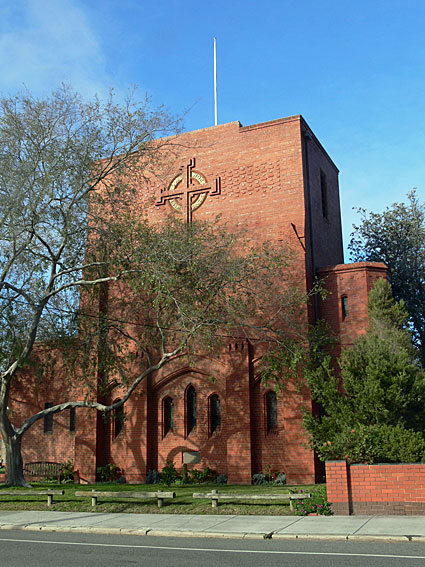
St Peter's Church, Murrumbeena: the main façade
[photograph by John Maidment (21 July 2012)]

St Peter's Church, Murrumbeena: the main façade
[photograph by John Maidment (21 July 2012)]
Historical and Technical Documentation by John Maidment
© OHTA, 2012 (last updated July 2012)
St Peter's Church was designed by Louis R. Williams, one of a number of large Anglican churches he was responsible for at the time, including St Silas' Church, Albert Park, the Church of the Epiphany, Northcote and All Saints' Cathedral, Bathurst, NSW. The foundation stone was laid in June 1924 and initially consisting of a very lofty western façade with a cross embedded in the brickwork. The building was envisaged as being cruciform, with a lofty tower and spire rising at the junction of the nave and left transept. However this lofty brick remnant remained until 1959 connected to an earlier timber church. The brick parts from 1924 were converted into a tower by Louis R. Williams and the building completed and dedicated on 6 June 1959 under his direction, elements resembling his almost contemporary work at St Andrew's Church, Brighton.1
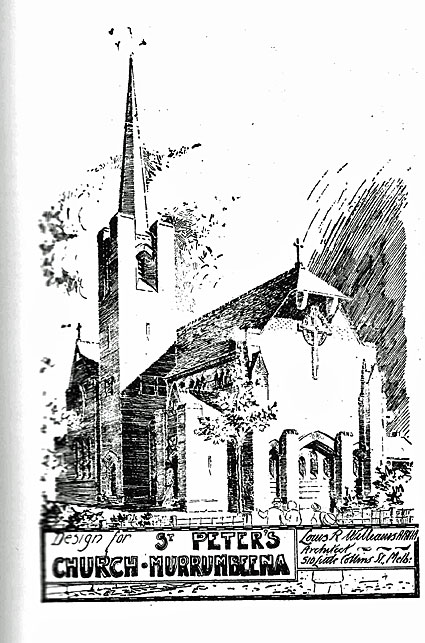
St Peter's Church, Murrumbeena: Louis R. Williams' design of 1924
[photograph by John Maidment (2012)]
The first pipe organ at St Peter's Church was built around 1885 by the South Australian organbuilder Daniel Heinrich Lemke for Immanuel Lutheran Church, Light Pass, South Australia. When this was replaced by a new organ in 1962, the Lemke organ was acquired by the organbuilding firm of Davis & Laurie Pty Ltd. It was restored by them and placed in St Peter's Church in 1963. In 1971 it was moved to St Peter's Lutheran Church, Frankston where it is still located.2
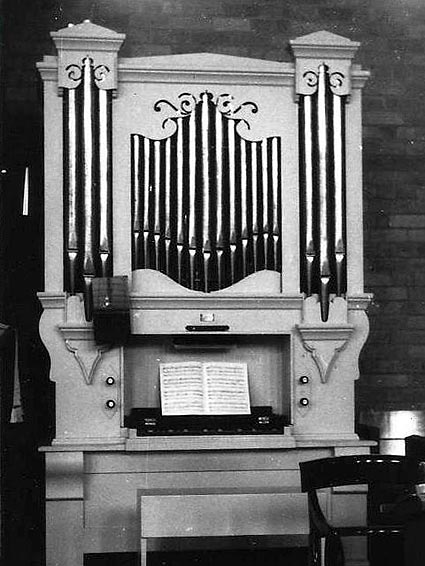
St Peter's Church, Murrumbeena: the c.1885 D.H. Lemke organ
[photograph by John Maidment (1965)]
In 1970, St Peter's Church acquired a larger organ from Holy Trinity Anglican Cathedral, Wangaratta, which had been displaced by an organ built by Alexander Young & Sons, Manchester that had been obtained from the UK.3 The second organ at St Peter's was built by Andreas Svensson who was born on 1 April 1840 at Lund, Sweden and trained as a cabinet-maker. He left Gothenburg on 10 March 1869 and arrived in Australia on 26 July 1869 on the ship Nation's Hope.4 He established a cabinet making workshop in Melbourne in 1873 and was making furniture both in Kent Street, Richmond and Latrobe Street, Melbourne.5 One of his children was named Malmo, the name of a major town in southern Sweden. It is not known when he arrived in Australia. He became one of the leading cabinet makers in Melbourne and his furniture is considered to be of outstanding quality. He died on 10 May 1917.6
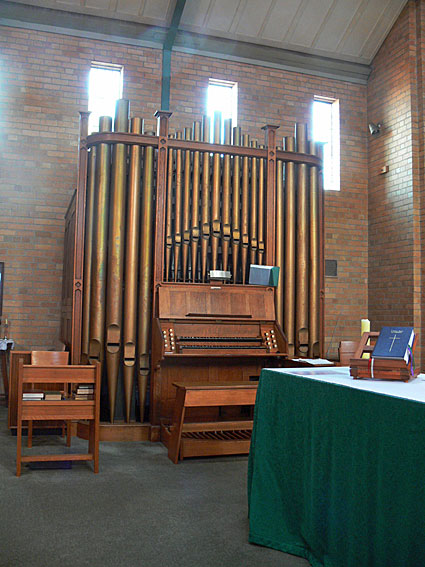
St Peter's Church, Murrumbeena: the c.1900-1910 Andreas Svensson organ
[photograph by John Maidment (21 July 2012)]
The organ appears to have been built for his home 'Klinta', 175 Kent Street, Richmond. He imported metal pipework from a continental supplier and possibly the console fittings, but would have made the wooden components himself.
A. & Y. Svensson, cabinet makers, 169 Latrobe Street, advised the availability of the organ to Melbourne organbuilders George Fincham & Sons Pty Ltd in two letters7 and it appears to have been installed at Holy Trinity Anglican Cathedral, Wangaratta by November 1926 when the old organ was sold to Holy Trinity Anglican Church, Benalla.8 The Svensson organ was installed in an organ chamber to the left of the chancel, but was clearly inadequate to support singing in this large building.
The Svensson organ was sold to St Peter's Anglican Church, Murrumbeena where it was installed by David Hudd for J.W. Walker & Sons Ltd in June – August 1970.
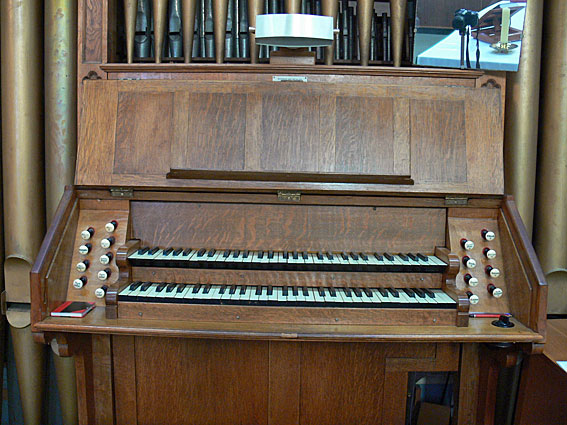
St Peter's Church, Murrumbeena:
the c.1900-1910
Andreas Svensson organ:
console showing oak fittings
[photograph by John Maidment (21 July 2012)]
The instrument is of interest for its fine oak case, the placement of the larger façade pipes at floor level (owing to its domestic origins, to economise on height), the use of imported spotted metal pipework with impressed mouths, the adoption of inclined stop jambs in the manner of Melbourne organbuilder William Anderson, scrolled keycheeks and its overall intactness. It is a rare example of an organ built by a Melbourne cabinet maker although in the 1930s and 1940s Clarence W. Andrewartha made a number of instruments exhibiting a high standard of skill.
The Svensson organ is an instrument of considerable mechanical sophistication and has an elegant, articulate sound. The adoption of a divided swell front shows an awareness of the problems of large lengths of timber warping and is rarely to be seen in local organs. The console is elegantly constructed. One wonders if Svensson had prior organbuilding experience in Sweden as the high quality achieved in this instrument couldn't have happened by chance.
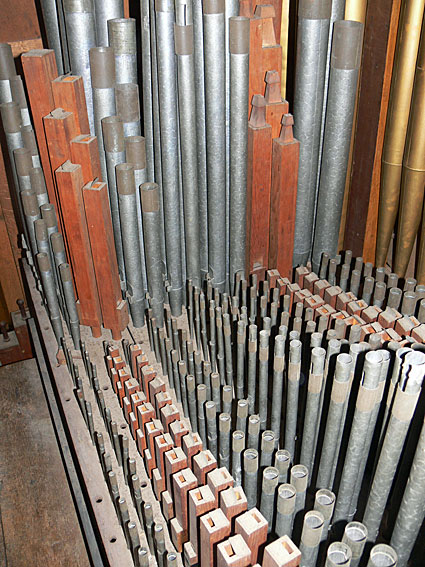
St Peter's Church, Murrumbeena:
the c.1900-1910 Andreas Svensson organ: Great pipework
[photograph by John Maidment (21 July 2012)]
It remains in a high standard of originality, later changes including the substitution of a balanced swell pedal for the original lever pedal, installation of tuning slides, provision of a 'Discus' blower, raising of the right-hand side oak panels to the top of the case, and supply of a new bench. Many of the original timber components in the key actions were replaced in metal in 1970 as was the fashion at the time.
| GREAT Open Diapason Clarabel Gamba Dulciana Principal Concert Flute Fifteenth Swell to Great SWELL Open Diapason Lieblich Gedact Keraulophon Principal Fifteenth Oboe PEDAL Bourdon Great to Pedal Swell to Pedal |
[8] [8] [8] [8] [4] [4] [2] [8] [8] [8] [4] [2] [8] [16] |
zinc bass in façade wood TC gvd.bass TC wood: inverted mouth gvd bass wood: drilled stoppers in treble gvd.bass ½ length CC-BB black metal |
Compass: 61/30
Mechanical key and stop action
2 composition pedals to Great
Balanced swell pedal (originally lever pedal)
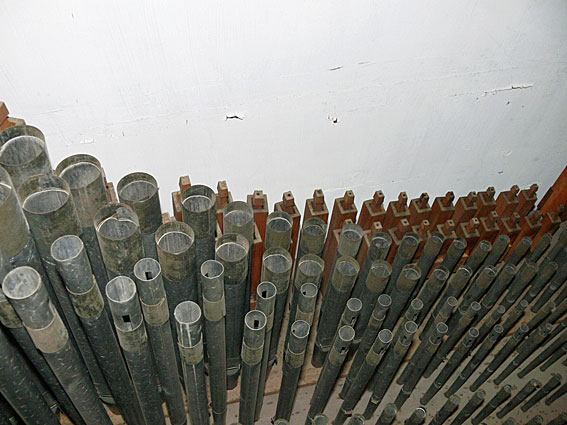
St Peter's Church, Murrumbeena: the c.1900-1910 Andreas Svensson organ : Swell pipework
[photograph by John Maidment (21 July 2012)]
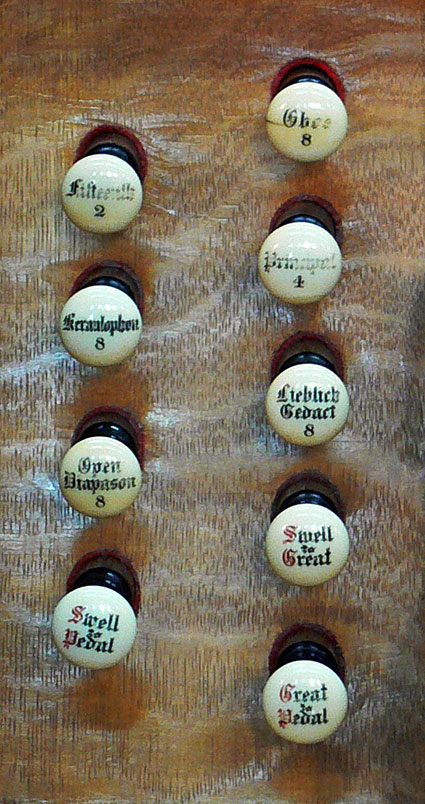
St Peter's Church, Murrumbeena: the c.1900-1910 Andreas Svensson organ : left hand stop jamb
[photograph by John Maidment (21 July 2012)]
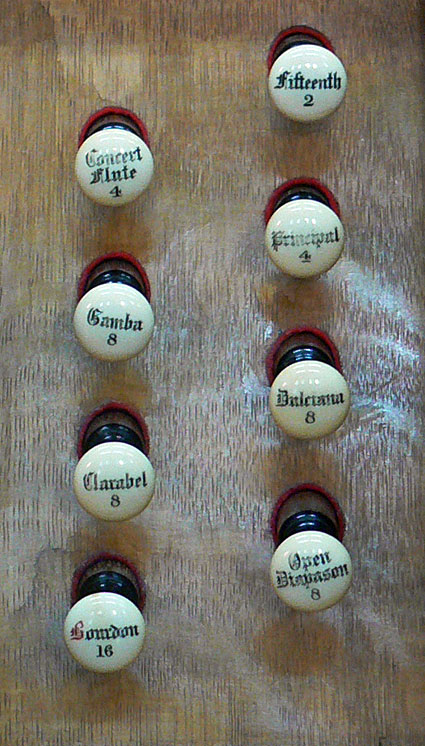
St Peter's Church, Murrumbeena: the c.1900-1910 Andreas Svensson organ: right-hand stop jamb
[photograph by John Maidment (21 July 2012)]
1 Alex Reid, Feeding Christ's Sheep: a history of St Peter's Murrumbeena with Holy Nativity Hughesdale (1999); The Argus, 7 June 1924, p.19 gives a drawing of the completed church
2 Author's notes 1965
3 Ibid
4 Internal marking in organ, noted by David Hudd 1970; emigrant register for Gothenburg (courtesy of Paul Peeters); Memorial to His Excellency John Henry Thomas Viscount Canterbury, Governor of the Colony of Victoria in Council, 4 March 1871 (naturalisation papers 4074 in the National Archives of Australia)
5 Kevin Fahy, Christina Simpson, Andrew Simpson, Nineteenth century Australian furniture, pp. 169, 605
6 The Argus 10 May 1920, p.1 giving Svensson's death date
7 George Fincham & Sons letters 'in' 5/155, 19, 28 November 1924 re placement of organ
8 George Fincham & Sons letter 12 November 1926